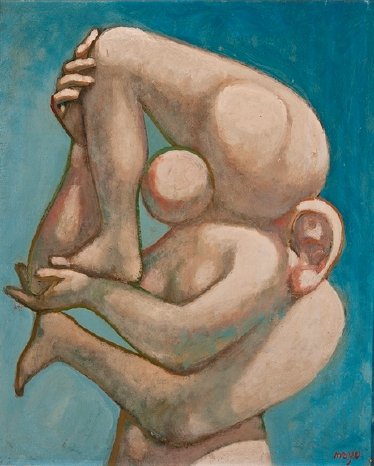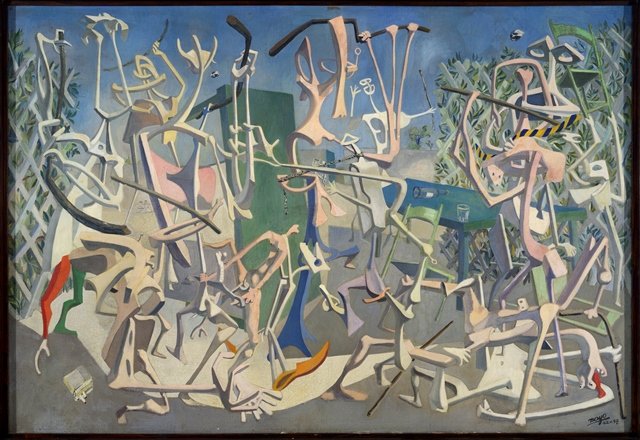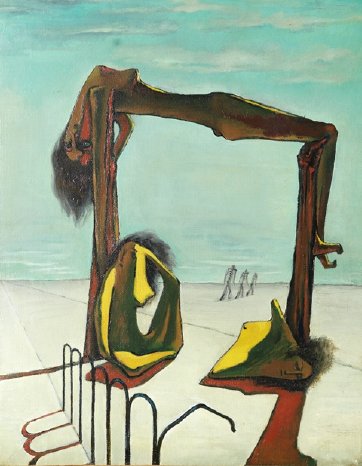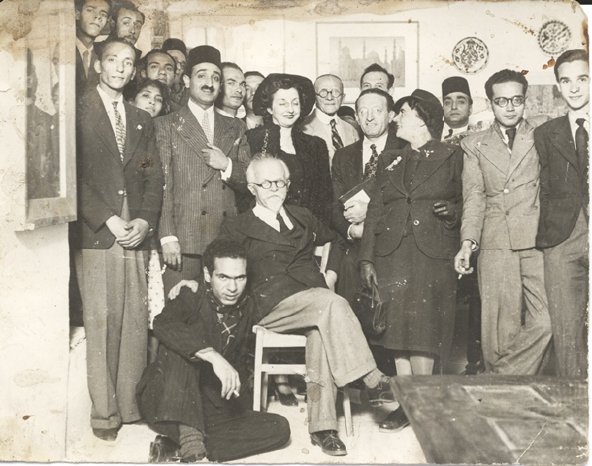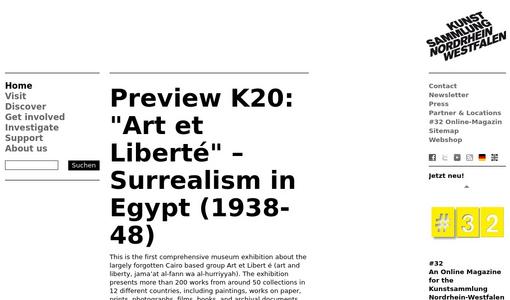Art et Liberté –
Rupture, War and Surrealism in Egypt (1938–1948)
July 15 – October 15, 2017
K20 Grabbeplatz
1938: in Berlin, Rome, and Moscow, the dictators are at the zenith of their power, and a fascist seizure of power is immanent in Spain as well. In many countries around the world, poets and painters, filmmakers, and photographers come together: for them, Surrealism is an expression of cultural resistance against fascism, colonialism, and nationalism. In this new exhibition, the Kunstsammlung Nordrhein-Westfalen in Düsseldorf documents the history of the nearly forgotten Egyptian artist's group Art et Liberté, founded in Cairo in 1938 on the eve of World War II.
Through numerous hitherto unknown artworks and historical documents, the exhibition Art et Liberté – Rupture, War, and Surrealism in Egypt (1938–1948) calls our attention to the fact that in Cairo as well, the often provocative and always poetic, subversive, anarchic Surrealist movement, with its intimate amalgamation of poetry and painting, stood firm against political repression and for the ideal of human freedom. With loans of more than 200 works from approximately 50 collections in 12 different countries, among them paintings, prints, photographs, films, books, and documents, the exhibition will be on view at the K20 from July 15 until October 15, 2017.
In two respects, Art et Liberté – Rupture, War, and Surrealism in Egypt (1938–1948) - conceived by guest curators Sam Bardaouil and Till Fellrath - is linked directly to the Kunstsammlung Nordrhein-Westfalen: the Egyptian artist's collective expressed solidarity with many of the artists who were persecuted by Hitler, Mussolini, and Franco, and who are also represented in the permanent collection of the Kunstsammlung. With programmatic intent, and alluding to the defamatory National Socialist propaganda exhibition, the international membership of the Art et Liberté group headed its manifesto, dated December 1938 and signed by 37 artists, writers, journalists, and lawyers, with the words: "Long Live Degenerate Art." In their appeal, illustrated with a reproduction of Picasso's Guernica, they issued the demand: "Together, let us overcome the Middle Ages that emerges from the heart of the Occident."
The exhibition at the K20 also serves as a prologue to the extensive show Excentric Modernism (working title), planned for autumn of 2018 at the K20 in connection with the multiyear research project "museum global" (2015 – 2018), which investigates manifestations of non-Western modern art on various continents. The artist's network F.I.A.R.I. (Féderation Internationale d’un Art Révolutionnaire Indépendant), closely linked to Surrealism, formed after the meeting between André Breton and Leo Trotsky in 1938 and with branches from New York to Santiago de Chile and Martinique, demonstrates how Surrealism as the first tendency of modernism exerted an international influence far beyond Paris and Europe. The "Art et Liberté" group in Cairo had a strong affiliation with the F.I.A.R.I. A number of Art et Liberté members´ writings were published in the F.I.A.R.I.´s journal.
With nine thematic foci, the exhibition present the political, aesthetic, and social engagement of the group Art et Liberté (jama´at al-fann wa al-hurriyyah), whose one of the most driving forces was the Cairo-based poet and literary critic Georges Henein (1914-1973). As early as 1930, Henein – the son of a diplomat and a cosmopolitan personality – had been closely associated with the Parisian Surrealists grouped around André Breton.
The presentation highlights the stand of this artist's group for a new Egyptian art and against academism and the linkage between nationalism and culture propagated by conservative forces at the Cairo School of Fine Arts. Before long, the kingdom of Egypt – still dominated by Great Britain – became a political as well as a military front in World War II while the Surrealist movement adopted an emphatically antifascist and anti-colonialist attitude in response to the rise of pro fascist sympathies in Egypt as well as in Europe. The battles in northwestern Egypt, death and destruction, are the themes of many paintings featured in the exhibition, the work of artists such as Kamel el-Telmisany, Inji Efflatoun, Fouad Kamel, Amy Nimr, Samir Rafi, and Ramses Younane, to name just a few.
By 1942 up to 140,000 soldiers from the British Empire were stationed only in Cairo; bitter poverty compelled many women to engage in prostitution. The paintings of the group Art et Liberté endow these "women of the city" (Henein) with artistic form. In general, the motif of the fragmented, ”emaciated body," as Art et Liberté artists referred to it, developed into an emblem of the howling social inequality between the large mass of poor country folk and the country's small number of feudal lords and business magnates.
For their own definition of surrealism, coined as "subjective realism” by Ramses Younane in contradistinction to the more familiar Surrealism of the European variety, these artists made use of locally familiar motifs and incorporated the subconscious into their artistic production, for example through the use of meditative Sufi exercises as traditional Islamic elements.
The close interrelationship between the written word and pictorial forms is another special trademark of this artist's group, which operated two independent publishing houses. In the space of 10 years, they brought out 30 books by major authors such as Edmond Jabès and Phillipe Soupault. Many Art et Liberté authors requested illustrations from their artist colleagues for their books or manifestoes.
With striking motifs, a number of Surrealist photographers left their mark on the circle around Art et Liberté. Unmistakable here as well are the typical expressive resources of Surrealist photography, including defamiliarization affects achieved through collage, montage, and solarisation. Moreover, photography provided a tool for the critique of nationalism as evident in the rag dolls and pharaonic heads of Ida Kar, Etienne Sved's fragments of ancient Egyptian sculptures, or the bizarre desert landscapes as depicted by the American photographer Lee Miller.
Curators: Sam Bardaouil, Till Fellrath (Art Reoriented, Munich and New York)
Curator at the K20: Doris Krystof
The exhibition was shown previously at the Centre Pompidou/Paris and the Museo Nacional Centro de Arte Reina Sofía/Madrid. After Düsseldorf, it will be shown at the Tate Liverpool (Nov 17, 17– March 18, 18), and finally at the Moderna Museet in Stockholm (April 21–Aug 19, 18).
Appearing in conjunction with the exhibition is the catalogue publication: Art et Liberté. Umbruch, Krieg und Surrealismus in Ägypten (1938-1948), edited by Sam Bardaouil and Till Fellrath, with a text by Sam Bardaouil, a foreword by Marion Ackermann and an essay by Doris Krystof. An exhibition catalogue of the Kunstsammlung Nordrhein-Westfalen, Düsseldorf, K20 Grabbeplatz 2017. Paris (Editions Skira) 2016 (224 pp. , numerous color illustrations, 35 euros in the Museum).
Sponsors:
The exhibition is sponsored by:
S.E. Sch. Hassan M.A. Al Thani
Schwarzkopf (Henkel Beauty Care)
Montblanc Kulturstiftung
Media partner: Handelsblatt
Funded by the Federal State of North Rhine-Westphalia
